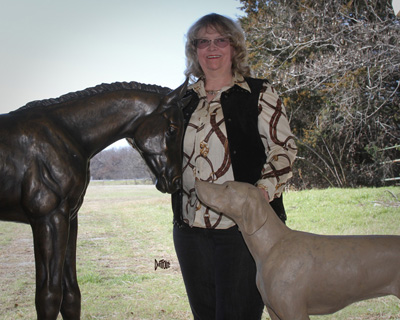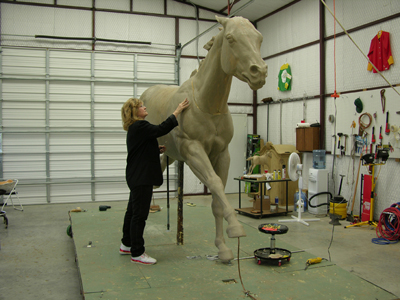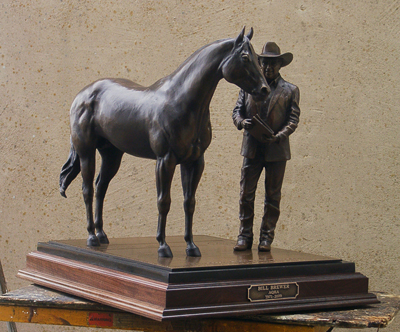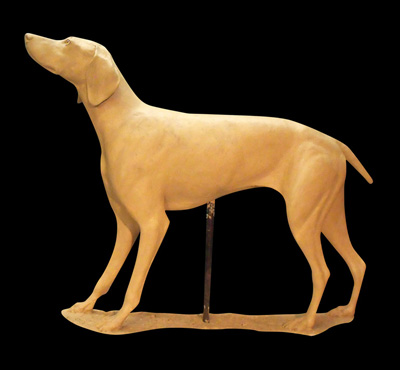 Raised on an old gold mine in Montana, artist Lisa Perry spent hours with her horse and dog exploring thousands of acres of national forestland surrounding her family’s property.
Raised on an old gold mine in Montana, artist Lisa Perry spent hours with her horse and dog exploring thousands of acres of national forestland surrounding her family’s property.
“I was searching for lost gold mines, exploring for old ghost towns and miners cabins, panning for gold and the big nugget,” she reminisces, “no, I never found it, but who would have thought that I would grow up to work with both bronze and gold!”
When she wasn’t out prospecting for gold, Lisa was inside playing with clay. Her first masterpiece was of course, a horse.
“They (horses) were my obsession. I was the kid in school who doodled horses in her notebook,” she reminisces. “My family always had horses so I was around them from the time I was a baby.”
Despite her early talents sketching and drawing, she was spellbound by the detail and lifelike features captured in the sculptures.
“My love of bronze started with Charley Russell’s work in the Montana Historical Museum where I spent many hours as a kid,” she says.
 Her passion for art and horses collided at Montana State where she majored in art and met her now husband, George. Like Lisa, he had a passion for horses. Not long after college, the couple married and made a living raising Quarter Horses, which they raced and showed. In 1979 the couple moved to Texas.
Her passion for art and horses collided at Montana State where she majored in art and met her now husband, George. Like Lisa, he had a passion for horses. Not long after college, the couple married and made a living raising Quarter Horses, which they raced and showed. In 1979 the couple moved to Texas.
For nearly a decade, Lisa’s art took the backseat to raising horses. Then in 1980, she decided to try her hand at sculpting again. Never intending to make it a full time career, Lisa was taken back when her work became an instantaneous success.
The first two pieces she sold in combination with a handful of orders totaled half of George’s annual salary. Soon it became clear that this was to be a regular occurrence. George eventually left his job to assist Lisa with her prospering business.
Her work It was clear from the beginning that Lisa’s work would be in high demand. She was soon booked with projects for private individuals and the public at large. Since 1980, she has been commissioned to sculpt bronzes racing trainer, D. Wayne Lukas, past presidents of the Jockey Club, the King Ranch and for the Governor’s mansion in Kentucky just to name a few.
 She’s also been hired for life size sculptures installed in parks for the public to enjoy. Such projects have included Kentucky Derby Winner, Alysheba, located out front of Lone Star Park, a sculpture of Legendary race horse trainer,”Mr All-American”, Jack Brooks in front of the saddling paddock at Ruidoso Downs Racetrack in Ruidoso Downs, New Mexico and a tribute to Texas oilfield workers on the first oil strike in Corsicanna, Texas.
She’s also been hired for life size sculptures installed in parks for the public to enjoy. Such projects have included Kentucky Derby Winner, Alysheba, located out front of Lone Star Park, a sculpture of Legendary race horse trainer,”Mr All-American”, Jack Brooks in front of the saddling paddock at Ruidoso Downs Racetrack in Ruidoso Downs, New Mexico and a tribute to Texas oilfield workers on the first oil strike in Corsicanna, Texas.
Of all the pieces she has completed, her favorite is a sculpture of Refrigerator, the All American winner and World Champion who welcomes visitors to The American Quarter Horse Hall of Fame and Museum. It took nearly a year for her to complete the 9 foot-tall and 16 foot-long replica of the racing champion.
“It’s my favorite because there’s so much action in it,” she says.
Her talents have garnered attention outside the equine industry. By virtue of winning a national competition in the 1990s, she was commissioned by Texas Tech University to create a life size depiction of an extinct prehistoric bison and a bear for the Lubbock Lakesite Landmark.
Working only with the aid of bone particles and expert sketches, she created a life size rendition of Arctodus Simus, the Giant Shortfaced Bear and Bison antiguus, an ancient Bison, both of which can be viewed at Lubbock Lakesite Landmark. “All projects have their own challenges, but this one was particularly unique,” she says.
 Getting to work Lisa modestly describes the most labor intensive part of the project as the foundry work that transforms her clay statue into a bronze for final display.
Getting to work Lisa modestly describes the most labor intensive part of the project as the foundry work that transforms her clay statue into a bronze for final display.
Once the clay sculpture is finished, the foundry fabricates a mold over the clay. Liquid rubber is used to capture every detail and a plaster shell is placed over the rubber to hold it in place. Next, wax is poured into the mold to create a pattern. During the final process the wax burns off and the bronze fills in the details. “It’s a labor intensive process,” she says. Once all of the pieces are complete they are welded together to form the final sculpture.
While it takes skilled artisans to transform the artwork from clay into a bronzed statue, the real work begins long before Lisa ever places her hands on the clay. First, she gets to know her model. “A lot of horses I am hired to sculpt are deceased, but if they’re still alive, I like to spend time observing them,” she says.
She studies the horse’s personality to identify distinguishing characteristics. “I pick up on traits that would allow someone to recognize the horse from its statue,” she explains. When she was hired to sculpt Distorted Humor for WinStar Farm she was fortunate enough to have an entire week with the stallion. She watched him frolic, eat and relax to learn his quirks. “They’re (horses) are all special in some way or another,” she says.
 During her observations, she snaps photographs and shoots video for reference while she’s working in the studio. Before leaving, she notes precise measurements from the horse’s withers to the width of his buttocks and point of hip, the length of his head, shoulder, forearm, cannon bone and the distance between his buttock and stifle. She also measures the width of the muzzle, width between the horse’s eyes and the length of its ears.
During her observations, she snaps photographs and shoots video for reference while she’s working in the studio. Before leaving, she notes precise measurements from the horse’s withers to the width of his buttocks and point of hip, the length of his head, shoulder, forearm, cannon bone and the distance between his buttock and stifle. She also measures the width of the muzzle, width between the horse’s eyes and the length of its ears.
No feature is too small Clients like Richard and Betty Jo Carr of Indiana can attest to the fact that no detail is insignificant. The couple hired Lisa to sculpt a statue for outside their barn. “We had always thought of a sculpture and decided we might as well have one that meant something to us,” Betty Jo, explains.
So the couple decided a statue that featured their Weimaraner, Emma touching noses with a foal. “Emma is totally attracted to baby foals, she does this pose and the foals come up and touch her nose,” she adds.
The Carrs first submitted photographs of Emma in action. “Of course horses and dogs do cute things, but when you bring a camera out they just don’t cooperate,” she laughs, “but we finally captured Emma posing and touching noses with a foal.”
Photos were enough to get Lisa started, but before she could finish, she wanted to meet Emma in person. Emma traveled to the All American Quarter Horse Congress for a meet and greet and for an official measuring session. “She (Lisa) kept redoing and remeasuring. She didn’t want the statue to be of any dog, but our dog,” Betty Jo says, “she wants to make the statue perfect.”
Life is a highway Lisa and George are on the road half the year traveling from one event to the next to showcase her work. Their horse trailer with living quarters is their “home away from home”.
When she and George are at home in Springtown, Texas they spend a lot of time with their herd of 12 horses and Sunny, a Macaw, Sunny. Every artist needs an assistant and Sunny is Lisa’s studio helper. The bird is also somewhat of a celebrity at the horse shows. “She has her own Facebook page where we record her adventures for her fans,” Lisa explains. One of Sunny’s favorite outings is canoeing on Caddo Lake in Texas where she can see the water birds.
For more information on Lisa’s work find her on Facebook listed under The Art Of Lisa Perry.



You must be logged in to post a comment Login